This article by Bernard Drew originally appeared in the Toronto Star and other newspapers in Canada around the end of August 1977.
Who knows what evil lurks in the hearts of Canadians? The Shadow knows…
“Pulp” fiction magazines, so-called because of the cheap paper they were printed on, were wildly popular in Canada and the United States during the Thirties and Forties. Although they were an almost totally American literary form, Canadians and the Canadian scene often appeared — not because the U S. authors had their Canadian audience in mind, but because our country and its people afforded what American readers thought were exciting (but accessible) locales, dappled with even more exotic heroes and villains.
Pulp stories covered almost every conceivable fiction genre — adventure, mystery, detectives and spies, war and air aces, love and romance, sports, western, horror, fantasy and science fiction — and superheroes. Recurrent stars were cultivated fully by the publishers, and included The Shadow and Doc Savage, The Spider, Nick Carter, Secret Agent X and many more.
The standard pulp magazine was 128 pages of untrimmed pulpwood paper bound between slick full- color covers. The editorial budget was similarly constrained. Writers, under pressure to earn a living at a penny or two a word, usually couldn’t afford to research their stories or rewrite after a first draft, so their prose suffered from stock situations, one- dimensional characters, and just plain hack writing (despite the fact that such eventually famous authors as Ray Bradbury, Philip Wylie and Tennessee Williams got their start in pulps).
Among the stereotypes to emerge in stories set in Canada — as you will read in the following examples — are scarlet-coated Mounties, strong-willed frontier women, and French guides named Pierre. Transportation is by canoe or dogsled; cities scarcely exist.
Only a ghostly reminder of the pulps — a few digest-size magazines — survive on the newsstands today. The pulps were killed in the late Forties by the emergence of the modern paperback and the advent of TV. But they left a rich heritage, and an interesting, if flawed, view of Canada and its people.
The Shadow, Master of the Paddle
The Shadow is probably the best-remembered American pulp hero. He appeared in a remarkable 325 issues of his own magazine, published by Street & Smith between 1931 and 1949, and was featured in a long-running radio serial as well. The Master of Darkness, as he was also called, visited Canada in the Feb. 15, 1936 issue of The Shadow Magazine. The North Woods Mystery, by “Maxwell Grant” (actually Walter Gibson), offers a typically audacious and stereotyped view of Canada — and is pulp fiction at its outrageous best.
The story begins in New York City’s Chinatown, where illegal Mongol aliens have been turning up, mysteriously carrying large amounts of counterfeit money. The Shadow, inspecting the pockets of one of the Mongols who has been killed, finds a clue. “‘This tobacco,’ he declares, ‘is the famous blend sold only by the Hudson Bay Posts.’” The Shadow reasons that the Mongol and others like him were smuggled into New York from the nearest outpost, at Lake Nimiskiming in Canada.
As the action shifts to that area of the North Woods, we meet Harley Creeland and his new bride Edna, who are on a fishing trip. They camp along the river, near the abandoned town of Red Cedar Rapids. The guide, Pierre (what else?) shows Edna a quaint rural post office, where outgoing and incoming mail is left unattended. “ ‘And no one steals the money?’ ” she asks.
“Edna shook her head as he smiled. She watched Pierre pick up envelopes, stare at them and replace them. This was certainly an honest country, wherein money as well as other property could be left unguarded.”
Glancing through the mail, Edna is surprised to find a letter addressed to herself. It is from Dale Mundon, a man to whom she had been engaged, until he had left town without explanation several months before. The letter suggests that Harley Creeland had something to do with Mundon’s sudden disappearance.
Meanwhile, The Shadow’s agent, Harry Vincent, is in the North Woods too. In the village of Wapiti Junction, he learns that Mongols have been imported to work on laying a new railroad track north to Hudson Bay.
Edna Creeland’s former beau Dale Mundon shows up at the lake, and talks with her while her husband is out in a canoe, fishing. Dale tells her that he was framed for embezzling money and was forced by Creeland to leave his job — and fiancée.
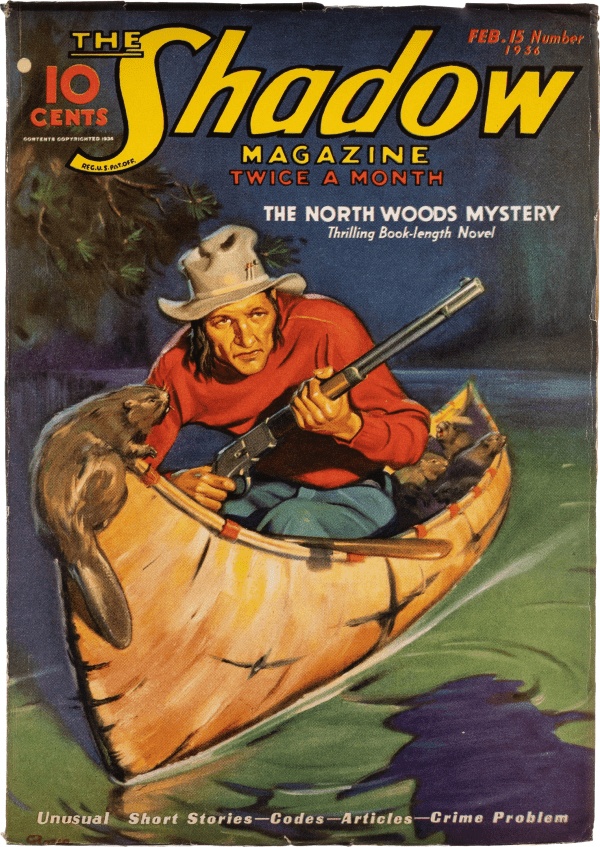
Harry Vincent and his guide, Alphonse (that’s what else), canoe around the lake. They meet the Creeland party and, later, Dale Mundon. They also meet an unusual Indian, who is accompanied by several beavers. Explains Alphonse:
“ ‘He is one man that is friendly with many beavers. The government pays him to go everywhere. Beaver, they follow him. They build in those place where Beaver Luke tells them. He is one Indian, Beaver Luke ’ ”
Harry Vincent has a midnight rendezvous with his boss, The Shadow. The Master of Darkness later does some investigating on his own, travelling the lake by canoe: “He was paddling in the fashion that Indians use when they approach unsuspecting water birds. No scraping betrayed his presence; for his paddle was clear of the canoe’s side.” Not bad for someone who’s spent much of his life in Manhattan!
Next day, Harry Vincent is captured by a group of Mongols near an abandoned mine shaft at the lake. Beaver Luke eventually finds him and helps him escape.
“Returning to his canoe, the Indian grunted to the big beaver who awaited him. The bewhiskered animal flopped from the canoe, gave a grunt and swam out into the lake, heading toward the creek. Beaver Luke had ordered his four-footed lieutenant back to the beaver colony.”
After complexity upon complexity, what seems real becomes false. Alphonse appears — he is actually Sergeant Dan McClay of the Northwest Mounted – and arrests some forest rangers, who are really hired thugs. Then Dale Mundon gets the drop on McClay. Mundon is the mastermind behind the Mongol smuggling and counterfeit smuggling operations, and he has been trying to frame Creeland. The situation looks grim. Harry Vincent, watching from the woods, is about to step in, when:
“From the very shore came a fierce, mocking laugh — a shivering cry of mirth that chilled everyone who heard it. It stopped the Mongols, rigid. It made the outlaws stare, as they held their rifles akimbo. As the shuddering taunt reached its full crescendo. Dale Mundon whirled to stare toward its author. There stood Beaver Luke. Erect, he was gripping mammoth automatics that he had brought from the pack in his canoe. Each .45 was levelled. Above them, lips still curdled the weird challenge; while eyes blazed toward the host of would-be murderers….”
Needless to say, the criminals haven’t a chance; The Shadow triumphs, in this both outrageous and wonderful pulp fiction of the 1930s.
Red blood in the Complete Northwest
For pulp fiction writers, the Northwest was a confused Alaska/Canada region populated by Frenchmen and Scots, fur traders and gold seekers. Readers were apparently enthusiastic for stories about the region, for publishers offered several magazines about the area, such as Complete Northwest Novel, which was launched in September, 1935.
The Yukon Trail by William MacLeod Raine is the lead story in the November, 1937 issue. In it, we meet Gordon Elliott and Ellen O’Neill, both Americans, and Colby MacDonald, a Canadian capitalist. All are on a steamship bound for Kusiak, Alaska. Elliott tries to court Ellen, but she becomes engaged to MacDonald (who is alternately called an Alaskan and a Canadian). Elliott, a government agent, gathers evidence about some of MacDonald’s mining operations, and there is intense rivalry between the two. When she learns that the Canadian is supporting a child by an Indian woman, Ellen is shocked and calls off the engagement.
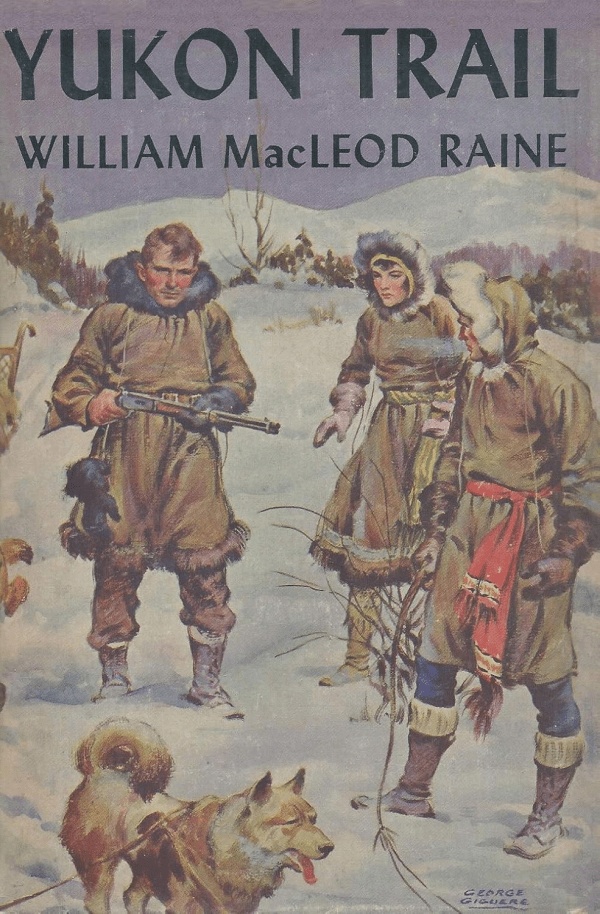
“‘You don’t understand.’ MacDonald’s big fists clenched so savagely that the knuckles stood out white from the brown tan of the flesh. ‘This is a man’s country. I’ve lived as all men live who have red blood in them. This woman is an incident…’”
Pierre Legrande, Fox of the Barrens
“With his face almost touching the snow upon which he sprawled, his rifle held out in front of him, Corporal John Royce of the Royal Canadian Mounted Police crawled forward toward the dark bulk of the cabin which stood out against the whiteness of the snow a hundred yards in front of him.
“Unless his information was incorrect, inside that cabin was Pierre Legrande, Fox of the Barrens, wanted for murder and robbery. For three weeks the corporal had trailed Legrande from hideout to hideout, and had run him down in the last of the French Canadian’s camps.”
— From Royce’s Luck by Bruce Harley, in the May, 1935 issue of Doc Savage Magazine.
The Yukon Kid and Kitty McGuigan
“In the days of old,
In the days of gold,
In the days of ’49 – “
In James B. Hendryx’ serial The Yukon Kid, Tommy Haldane makes a fortune in the Klondike, earns the nickname “Yukon Kid,” but loses his true love, Kitty McGuigan, whom he left behind in Skagway, Alaska on the eve of their wedding so that he could seek his fortune.
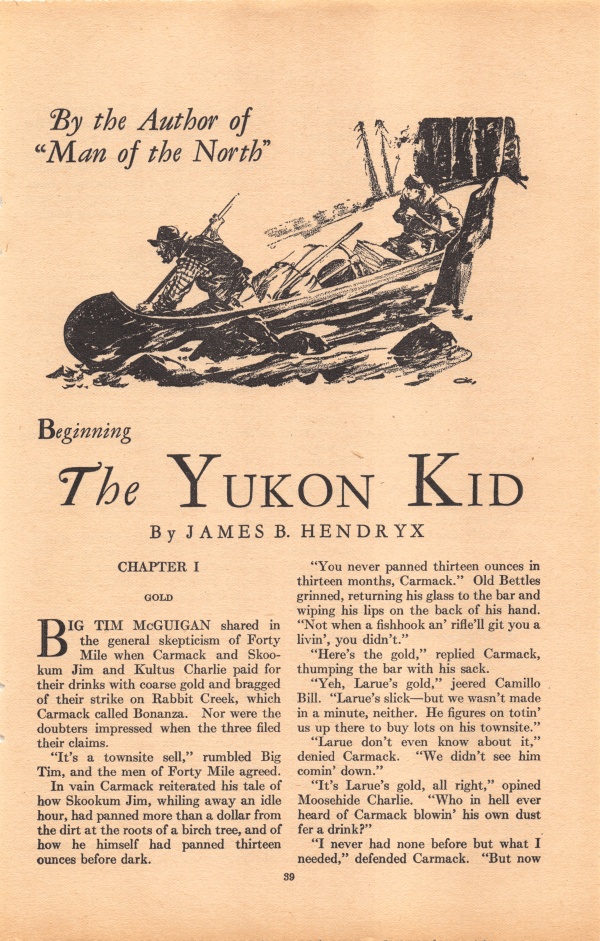
Kitty has fled in anger to the U.S. and Tommy follows her. Kitty sees his newspaper advertisements, but thinks the police are after her for an unpaid board bill that she owed a vindictive aunt. She travels to Winnipeg, and learns of the now-legendary Yukon Kid, unaware that he has been her lover, Tommy Haldane.
Dancing at the Olympic theatre, Kitty meets Mr. Jones, “a banker from Edmonton,” who buys her a ticket to Dawson and promises to meet her there shortly, after he settles a score with some men in his bank. Jones, however, is a married man and a crook, and he absconds with the bank’s deposits.
Jones kills his guide, Pierre (what else?) Gatineau, and disguises the body as himself to mislead the North West Mounted Police. However, Inspector Downey, who is assigned to the case, is not easily confused. He locates the body, correctly identifies it and questions Jones’ wife, who tells him about Kitty McGuigan.
Meanwhile, Kitty meets an old friend, Camillo Bill, a bearded mountain man who arranges passage for her on a boat going back to Skagway. Kitty’s old friends make sure that she doesn’t learn the Yukon Kid’s real identity — they want the meeting to be a surprise.
Inspector Downey arrives in Dawson, questions Kitty, and sees that she has been deceived by Jones. Tommy “Yukon Kid” Haldane returns to the town, unaware that Kitty is there too. Both attend a sourdough banquet, and arc happily reunited. At the same party, Downey spots the bank robber Jones; there is a light, and the crook is captured.
All of this took place in the September, October and November, 1933 issues of Adventure.
Constable Magee’s $1.75 per day
J. Allen Dunn either did an extraordinary amount of research or, more likely, swiped an RCMP manual for his story Magee of the Mounted (Argosy, Feb. 2, 1935). Consider this paragraph, overflowing with detail:
“Regimental Number 10193, Constable Andrew Magee, second class, drawing $1.75 per diem, with certain privileges of free dental work, hospital and clothing issues; with the possibility of rising to an inspectorship and maximum pay of $2,050 per annum, or to one of the 18 superintendencies with a top of $2,650, might, even in that remote detachment and command, be called upon to solve vital problems.”
Buried in this dull prose is the story of a criminal who kills a Mountie and assumes his identity as Magee’s new superior officer at the remote Rampart outpost in northern Alberta. Magee and his Indian aide, Johnny Bruno, don’t catch on to the crook’s deception until a storekeeper is robbed and killed, and the attractive Miss Lee Brill is kidnapped. Magee races to her rescue in the cold country, and shoots the impersonator between the eyes. “ ‘I knew always that you would come — in time,’ ” Miss Brill tells her man.
Pierre Ladeux—“from ze Hudson Bay contree”
A New York City promoter interviews a French Canadian, Pierre (what else?) Ladeux, in Carl H. Claudy’s The Book Fighter, in the February, 1927 issue of Everybody’s. Ladeux is working as a waiter, but displays characteristics that might make him a fine boxer. The promoter wants to know more about his background.
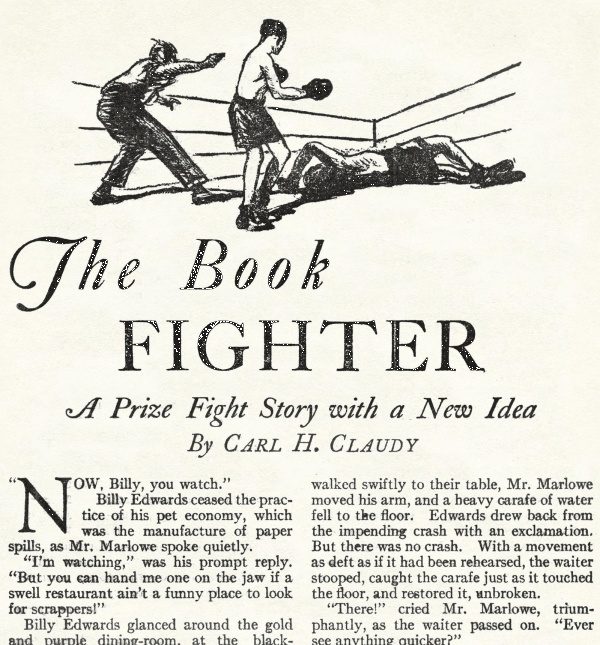
“‘You are a woodsman, a lumberman, trapper?’
‘Oui, m’sieu. From ze Hudson Bay contree.’
‘You like this — being a waiter?’
Pierre Ladeux smiled ruefully. ‘I come out here wiz ze fine skins — oui — ze silvaire fox. I sell heem much money. Zen I los’ eet. I am rob’. Now I mus’ work or – I not eat. In Quebec, once I sarve at ze hotel. Zis waitaire, zey stop work — strike, you call eet? Oui. So I am ze waitaire.’ ”
All-Story Cavalier: Laura could sing, too
Canadian women in the pulps are beautiful, capable, and totally self-sufficient. Consider Miss Laura MacLeod, daughter of Factor MacLeod, of the Hudson Bay area. She is adored by “every man, breed and beast, from Repulse Bay down to Moose Factory,” we are told in Stephen Allen Reynolds’ Beyond the Timber Line, in the Oct. 10, 1914 issue of All-Story Cavalier.
“She could speak Cree, Yellow Knife, Dog Rib and Kenipatoo; could hitch and drive her father’s dogs as well as Tiglikpoo, the crack Churchill whip; could bring down a bounding caribou at 500 yards with a single shot from her dainty high-power .25, and she thought little of spending a week on the desolate Barrens, when the mercury hugged the bottom of the tube and the fat shore Inuits hugged their igloos.
“And yet you couldn’t find a sweeter or tenderer little woman than Laura. I’ve seen the tears come to her blue eyes while she was bandaging the broken paw of a malamute pup. I’ve seen her keel over in a dead faint at the sight of a Whale Point half-breed who was brought into Churchill after creeping up on a she-bear with a bum cartridge in his Winchester…. Her chocolate layer cake was the best ever— And she could sing, too.”
“Werewolf! Indian know them”
A werewolf and lovely cousin Patricia distinguish Doc Savage’s first Canadian adventure, Brand of the Werewolf, written by “Kenneth Robeson” (Lester Dent) and published in the January, 1934 issue of Doc Savage Magazine. The popular Street & Smith pulp hero and his five-man band of crime-fighters are travelling west on a Canadian train when they become mixed up with mysterious Spaniards, a murder, a lost pirate’s treasure, and a werewolf.
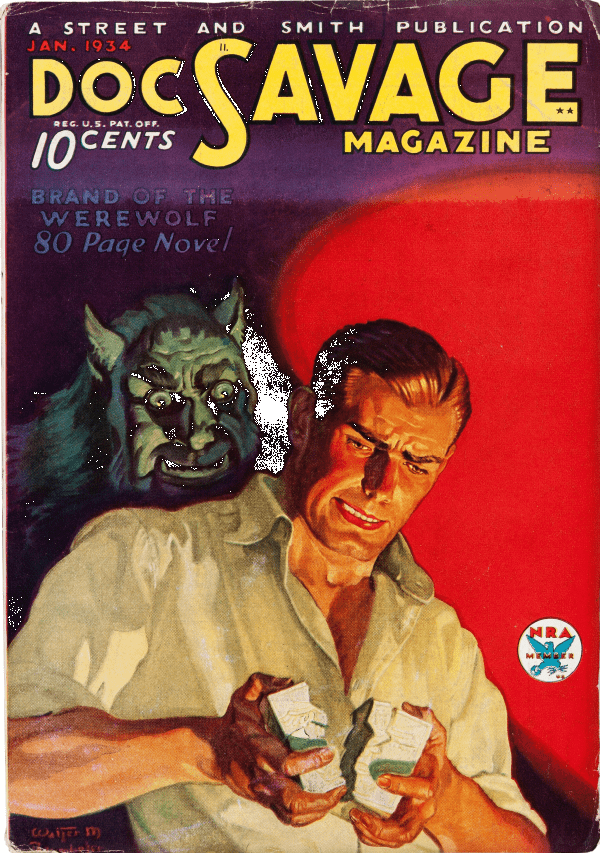
A werewolf in Canada?
“‘There ain’t no such critter,’ ” says one character. “ ‘It’s just a legend of these Canadian trappers and natives.’ ”
“ ‘Werewolf! Indian know them,’ ” says a native. “ ‘They devil-man with body of wolf. They prowl in woods and eat plenty hunter and trapper.’ ”
In any event, the story marks the first appearance of Doc Savage’s bronze-haired cousin Pat, who was not only one of the few major female characters to appear regularly in pulp stories, but was also virtually the only character of Canadian origin to do so. She is as impressive and capable as her superhero cousin:
“She was tall; her form was molded along lines that left nothing to be desired. Her features were as perfect as though a magazine cover artist had designed them. She wore high-laced boots, breeches and a serviceable grey shirt. A cartridge belt was draped about her waist. From it dangled a heavy Frontier Single Action six- shooter — freely admitted by those who know to be one of the most reliable guns ever made In the crook of her right arm lay a very modern automatic big-game rifle.”

Les quatre rois and frantic sleds
Canadian women are independent but occasionally foolhardy. Virginia Hampton, living at a wilderness post with her brother, disregards his advice and drives her sled team more than an hour from their camp. She becomes lost in a sudden storm. “ … being young and feminine … (she] had felt very competent and able to take care of herself.”
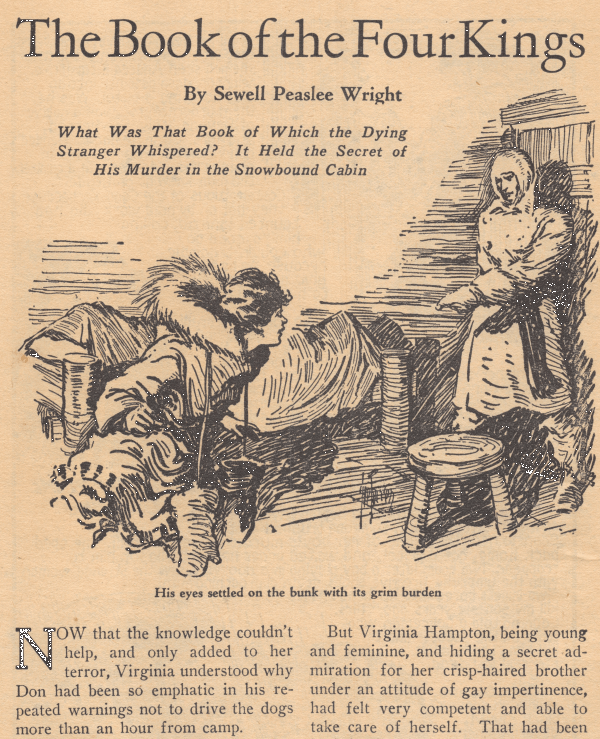
Virginia makes her way to another camp, where she finds a dying man. He entrusts her with a message about livre des quatre rois before expiring. The clue in a deck of cards and a frantic sled chase after a murderer conclude the story The Book of the Four Kings by Sewell Peaslee Wright in the March 31, 1934 Detective Fiction Weekly.
What turned The Avenger’s hair white?
The crime-fighting Avenger, Richard Benson, is introduced in the novel-length story, “Justice, Inc.,” by “Kenneth Robeson” (Paul Ernst, this time) published in the September, 1939 issue of The Avenger Magazine. Benson becomes a vigilante after his wife and daughter disappear during an airplane flight to Montreal. They were going there to see the wife’s mother, who was ill. The tragic disappearance of his family turns Benson’s hair prematurely white and affects the nerves in his face, so that he can manipulate the skin and approximate the appearance of others without makeup.
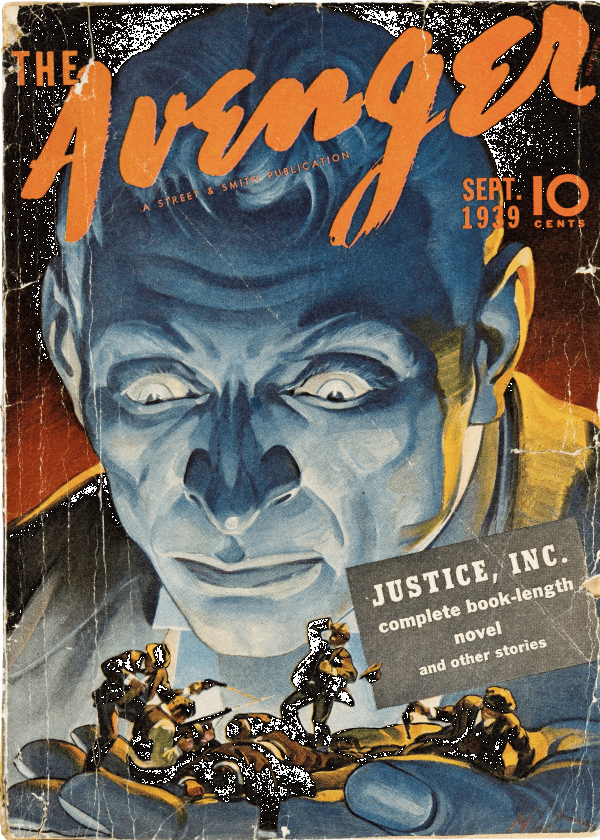
Richard Benson returns to Canada several times in his pulp magazine career. In The River of Ice (The Avenger Magazine, July, 1940), the tomb of some Aztec-like people is found beneath the ice in northern British Columbia and The Avenger helps the discoverers protect their find from crooks who want to steal its treasures.
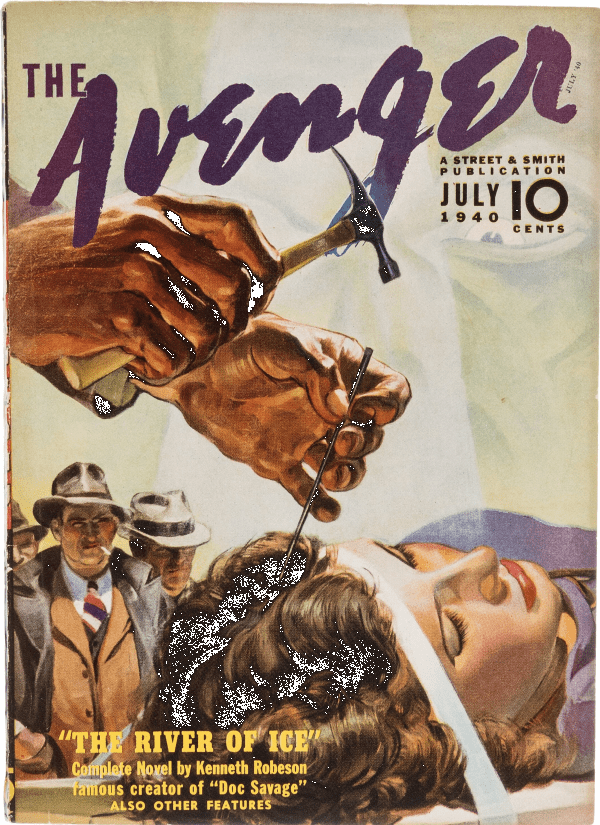
In the next issue’s story, The Flame Breathers (September, 1940), The Avenger returns to Montreal to investigate the mysterious death of a scientist. He has no difficulty getting cooperation from the city police:
“ ‘We’ve arrived at a number of conclusions that we have kept from the reporters,’ the police chief said. He was very respectful in tone. Every police executive on the continent knew about The Avenger.”
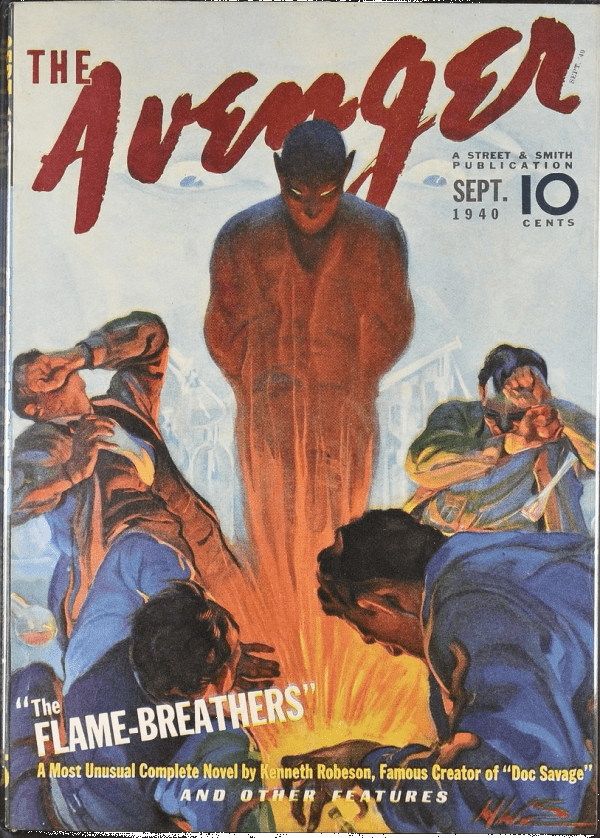
Doc Savage and “zat airplane engine story”
“The overalled men crowded into the hangar. They were a wolf-faced crew.
‘Zat airplane engine story is smart trick, non?’ queried one.
Monk and Ham (aides of Doc Savage] knew accents. They marked this fellow as a native of northern Canada, a breed of French descent. The others seemed to be of the same nationality.”
That’s an impressive talent — being able to not only distinguish the place of a man’s origin, but pinpoint his parentage by the way he speaks eight words. Anything is possible in the pulps.
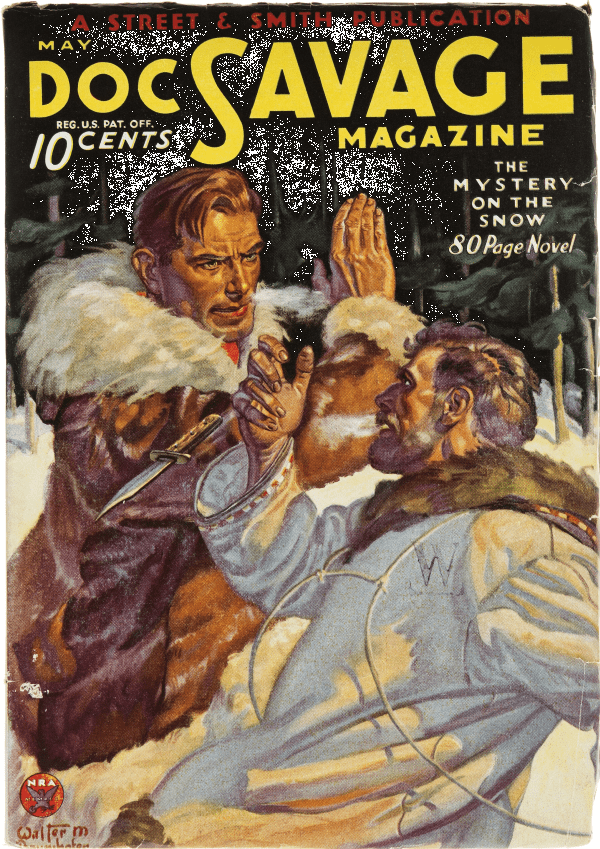
In Mystery on the Snow by “Kenneth Robeson” (Dent again, in Doc Savage Magazine, May, 1934), a group of men tries to keep Doc Savage and his pals from helping Ben Lane. Lane, who lives in the Snow Mountain area of northern Canada, has discovered a mineral substance valuable to steel refining, but dangerous to the interests of some industrialists.
One minor character, Miss Midnat D’Avis, a pretty Montreal detective hired by Lane, proves to be a capable person in a skirmish with the Mounties:
“The young woman promptly kicked off her snowshoes, in order to move more freely, and rushed Captain Stonefelt. She hit him in the eye, on the nose. She clutched her rifle and had almost recovered it, when a policeman ran forward and seized her, holding her.
‘Whe-e-w!’ sputtered Captain Stonefelt. ‘What a tigress!’ ”
And so we were — or so we seemed to a couple of generations of American pulp-readers. Goodnight, Alphonse. Goodnight, Pierre.
This article somehow ignored the one pulp title it should have covered. Northwest Romances specialized in Northwesterns. It featured stories of Canadian Mounties, prospectors in peril, fur pirates, wild sled dogs, wilder wolves and the savage North.
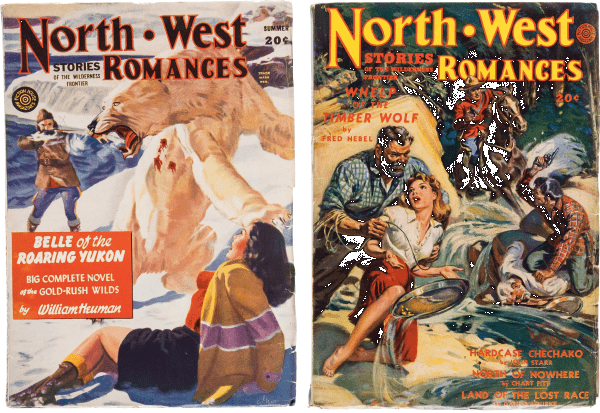
Time for some reviews? Maybe.